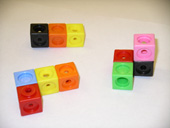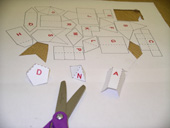Or search by topic
Number and algebra
Geometry and measure
Probability and statistics
Working mathematically
Advanced mathematics
For younger learners
Published 2004 Revised 2012
Thinking 3D
The NRICH team develop problems for the whole site collaboratively, choosing themes that can be explored by children from 5 to 19. When the team are faced with the topics such as "3D geometry" we often need to pause and think about what this might mean for younger pupils. When thinking of 3-D, our initial thoughts ranged around planes and intersecting lines, three dimensional coordinate geometry and all sorts of 'hard and scary' maths. How could we begin to introduce these ideas to young children? Where do they start? What are the key concepts that we could introduce so that young children can gain some insight into this challenging area of maths? How could we lay the foundations for a later enthusiasm for working in three dimensions?
We thought for a while and then realised that the starting point for very young children is the language that we use to describe positional relationships of objects in space. Behind, beside, in front, to the left, to the right are all important in the development of children's understanding of objects in three dimensions. From this idea we developed the Building Blocks problem.
 This problem challenges pupils to transfer a 2D representation of a 3D object into a model of the object itself. The practical context provides a need for children to use positional language. One hint suggests starting from an 'end' of the object, but however the problem is
approached, there is no doubt that the relative positions of the cubes must be considered. Using the 2D image to point at, and linking cubes shown in the picture to cubes held by the children, we can facilitate their problem solving. Asking questions such as 'Is there a cube to the right of this one?' or 'Where is this cube compared with that one?' might be useful prompts. Encouraging pupils to
discuss their models as they work will also aid their language development.
This problem challenges pupils to transfer a 2D representation of a 3D object into a model of the object itself. The practical context provides a need for children to use positional language. One hint suggests starting from an 'end' of the object, but however the problem is
approached, there is no doubt that the relative positions of the cubes must be considered. Using the 2D image to point at, and linking cubes shown in the picture to cubes held by the children, we can facilitate their problem solving. Asking questions such as 'Is there a cube to the right of this one?' or 'Where is this cube compared with that one?' might be useful prompts. Encouraging pupils to
discuss their models as they work will also aid their language development.
 Right or Left? also requires understanding of positional vocabulary, but this time the focus of the problem is visualisation. In this case, children could use dice or cubes to help them tackle the
problem. This might help scaffold their ability to visualise. It also begins to equip them with skills that they will need to draw on at a later stage in their mathematical development when concrete models may not be available or appropriate. Being able to visualise is the key to success in 3D geometry and the problems Shadow
Play and Cut Nets offer other valuable contexts in which to practise this skill. Once again, the solutions can be arrived at by practical demonstration so that pupils can make the leap from 'seen' to 'imagined'.
Right or Left? also requires understanding of positional vocabulary, but this time the focus of the problem is visualisation. In this case, children could use dice or cubes to help them tackle the
problem. This might help scaffold their ability to visualise. It also begins to equip them with skills that they will need to draw on at a later stage in their mathematical development when concrete models may not be available or appropriate. Being able to visualise is the key to success in 3D geometry and the problems Shadow
Play and Cut Nets offer other valuable contexts in which to practise this skill. Once again, the solutions can be arrived at by practical demonstration so that pupils can make the leap from 'seen' to 'imagined'.
 Cut Nets centres on another important collection of concepts - the common mathematical solids which include the cube, cuboid, prism, sphere and cone. Children need to be able to
develop an understanding of what these polyhedra look like, and to be given the chance to explore their faces and the way in which those faces fit together. Cut Nets provides these opportunities and will help to develop the ability to visualise a solid in the absence of a model. In addition, nets are another frequently used way of representing a 3D shape in two dimensions, and it is important
that pupils appreciate their helpfulness.
Cut Nets centres on another important collection of concepts - the common mathematical solids which include the cube, cuboid, prism, sphere and cone. Children need to be able to
develop an understanding of what these polyhedra look like, and to be given the chance to explore their faces and the way in which those faces fit together. Cut Nets provides these opportunities and will help to develop the ability to visualise a solid in the absence of a model. In addition, nets are another frequently used way of representing a 3D shape in two dimensions, and it is important
that pupils appreciate their helpfulness.
Our problem Chain of Eight Polyhedra also focuses on the properties of 3D shapes, and in particular on the characteristics of their faces. Analysing the polyhedra in this way and getting to grips with the associated vocabulary will equip children with the confidence to talk clearly and easily about three dimensional problems.
Triangles to Tetrahedra combines all of the above skills and concepts, and draws too on the notion of combinations. In tackling this problem, knowledge of the properties of a tetrahedron is essential, but almost immediately other questions come to mind. How is the length of the sides of the triangular faces important? Can it simply be a matter of combinations? What other factors do I need to consider? In answering these questions, children will be using positional language, visualising and applying what they know about properties of shapes. And of course they will be describing, reasoning, hypothesising, justifying and explaining, which are all key mathematical skills.
And so, in conclusion, we are now convinced that 3D geometry for younger children is not 'hard and scary'. If we create problems like these to give our pupils a good grounding in this topic, equipping them with complementary knowledge and skills, then perhaps three dimensional problems will never become 'hard and scary' at all.

